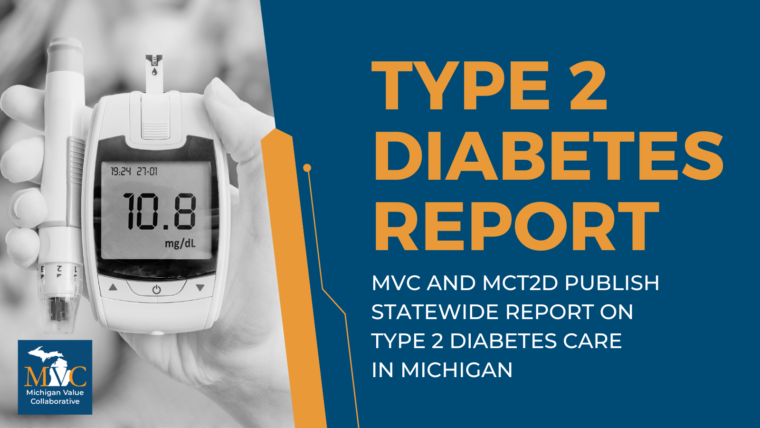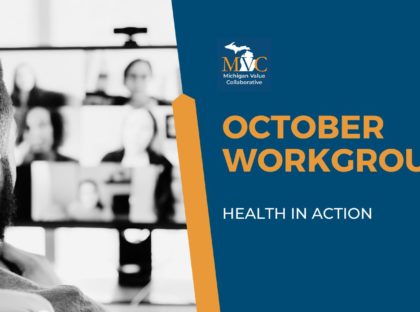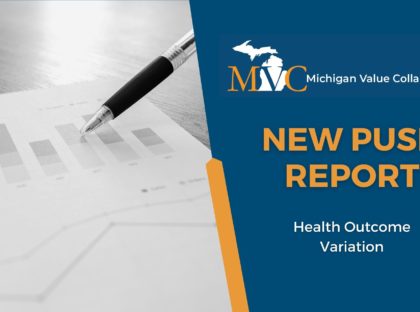Chronic disease management was a key driver of healthcare utilization over the last decade and has been cited as the most expensive chronic disease in the U.S. In response, MVC recently partnered with the Michigan Collaborative for Type 2 Diabetes (MCT2D) to develop a statewide report on Type 2 Diabetes (T2D), a chronic illness that impacts over 1 million adults in Michigan. This new report was recently shared by both MVC and MCT2D at the Michigan Obesity Summit and will be distributed to MVC member hospitals later this week.
The report summarized demographics, healthcare utilization, and prescription patterns among those patients with T2D in Michigan insured by Blue Cross Blue Shield of Michigan (BCBSM), Blue Care Network (BCN), Medicare Fee-for-Service (FFS), and Michigan Medicaid between 2017 and 2023. To create this report, MVC first used its claims data to identify beneficiaries aged 18 and older with a qualifying T2D diagnosis in the past year. After identifying annual cohorts of beneficiaries with T2D for each year, 2017-2023, MVC assessed annual utilization of T2D prescription medications, emergency department (ED) visits, inpatient hospitalizations, and provider visits.
MVC assessed filled prescriptions among T2D beneficiaries with corresponding prescription coverage using its pharmacy claims. This was the first time MVC included prescription claims data in a member push report and the first time that prescription claims from all MVC payer sources were utilized in a single MVC analysis. Medicare beneficiaries were excluded from 2022 and 2023 prescription utilization rates because Medicare pharmacy claims were only available through 12/31/2021. Diabetes-related drug classes were identified in pharmacy claims based on National Drug Code (NDC) as well as standardized prescription names and classes.
Newer medications such as GLP-1 receptor agonists and SGLT2 inhibitors are frequently prescribed to improve glucose control, reduce mortality, slow kidney disease progression, and aid in weight loss. The American Diabetes Association now recommends the use of these medications for patients with cardiovascular disease, kidney disease, and obesity. In keeping with these guidelines, MVC’s analyses indicated a large increase in utilization of GLP-1 receptor agonists (3.1% to 18.6%) and SGLT2 inhibitors (2.3% to 14.2%) between 2017 and 2023 (Figure 1). In the same period, prescriptions decreased from 2017 to 2023 for insulins (20.9% to 16.5%) and sulfonylureas (17% to 10.9%).
Demographic characteristics including age, sex, race (Figure 2), and insurance provider (payer) were described within the report for all beneficiaries with T2D across all payers 2017-2023 and compared to the characteristics of all beneficiaries reflected in MVC data during those years. Compared to all beneficiaries, those with T2D were older, with an average age of 66 years versus the average of 43 years among all beneficiaries. T2D beneficiaries were also more likely to be male (50% vs 43%), Black (20% vs 15%), and more often covered by non-commercial insurance plans (45% vs 28%).
From 2017 to 2023, rates of diabetes-related ED visits and hospital admissions remained relatively infrequent among T2D beneficiaries. Around two percent of T2D beneficiaries visited an ED for a reason related to diabetes each year, and one percent were hospitalized in relation to diabetes. ED utilization unrelated to diabetes decreased from 37.4% in 2017 to 33.1% in 2023 among T2D beneficiaries (Figure 3). Hospital admissions unrelated to diabetes decreased from 21.3% to 16.4% (Figure 4).
In contrast, T2D beneficiaries saw primary care physicians, nephrologists, and endocrinologists more frequently between 2017 and 2023, with observed increases for all three provider types (Figure 5). Most notably, visit utilization with primary care providers increased from 18.3% to 32.9%. Nephrologist visit utilization increased from 1.2% to 2.2%, and endocrinologist visit utilization increased from 1.9% to 3.6%.
This new report created in partnership with MCT2D provided a high-level overview of healthcare utilization among T2D beneficiaries within Michigan. Since the analyses utilized data derived from medical insurance claims, one key limitation was the exclusion of uninsured individuals as well as key indicators of T2D outcomes that are not accurately captured in claims data, such as HbA1C levels, blood pressure, continuous glucose monitor utilization, and retinopathy screening. Despite these gaps, the data revealed promising trends in diabetes care, including increased primary care visits, greater use of guideline-directed medications proven to show significant benefit, and reduced emergency department visits. MVC’s analyses also underscored areas for improvement, such as the need to address health equity gaps and continued promotion of guideline-directed medical therapy.
MVC will share copies of the completed report directly with members later this week, and a copy is also available on the MVC website [PDF]. If you are interested in pursuing a custom analysis for any of these measures or a different tailored custom analysis, please reach out to MVC.









